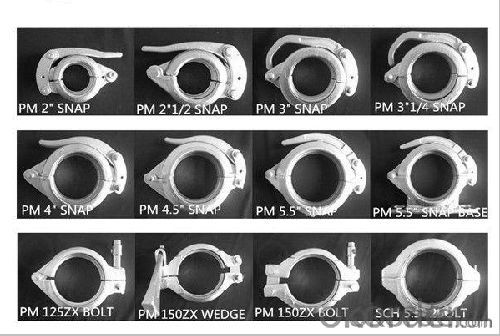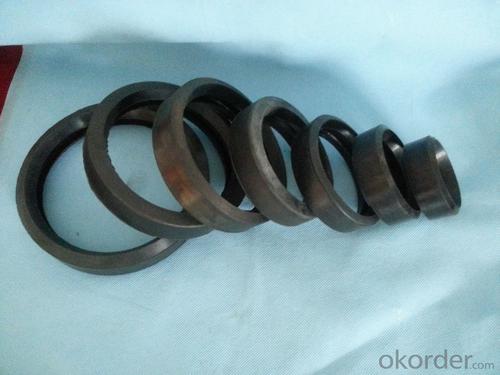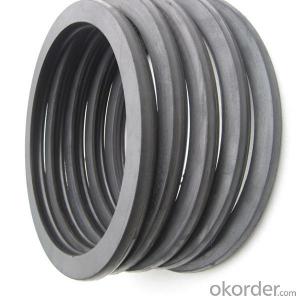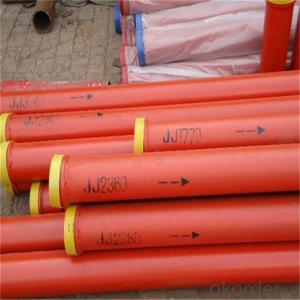Concrete Pump Parts of Rubber Gasket from CNBM
- Loading Port:
- China main port
- Payment Terms:
- TT or LC
- Min Order Qty:
- 1000 PCS
- Supply Capability:
- 100000 PCS/month
OKorder Service Pledge
OKorder Financial Service
You Might Also Like
DN125/5.5" Concrete Pump rubber gasket



Rubber Seal is used to fulfill the airgap between concrete pump parts.
FAQ
1.How do you regarding your product quality?
As our principle is more safety to save more. In China, there are lots of manufactures of this line, but we are the first one that use the forging technic in producing, firmly meet the PM standard.
2.Can I get some samples?
Of course you can. Small sample for free, but you pay the express. For some products are not small, like concrete pump pipe, it’s very difficult to deliver one pipe of 3000mm. If it’s possible, we’d like that you can come here to visit our factory. Welcome!
3. I want to make our logo on the products, is that ok?
Yes, it’s totally ok. OME is available from us.What you should do is send your logo, brand name, or picture to us. And let other things leave on us.
Q1: How soon can we receive the goods after purchase?
A1: Within three days of placing an order, we will begin production. The specific shipping date is dependent upon international and government factors, but is typically 10 to 30 workdays.
Q2: How to make a quick resolution for after service?
A2: OKorder and our manufacture both have overseas branches all-around of world, If needed, the seller shall dispatch 2 engineers to the buyer's site for supervision of training. The buyer shall make available of necessary facilities & skilled personnel at site for training.
Q3: How do we guarantee the quality?
A3: We have established an advanced quality management system which conducts strict quality tests at every step, from raw materials to the final product. At the same time, we provide extensive follow-up service assurances as required.
Main Product Features:
· Premium quality
· Prompt delivery & seaworthy packing (20-40 days after receiving deposit)
Reliable performance
Easy and smooth operation
High safety.
· Professional Service
· Competitive pricing
- Q: How can one ensure proper documentation and record-keeping for concrete pump spare parts?
- To ensure proper documentation and record-keeping for concrete pump spare parts, several steps can be taken: 1. Establish a systematic inventory management system: Implement a well-organized inventory management system to keep track of all the spare parts. Assign unique codes or identification numbers to each part and maintain a comprehensive inventory list. 2. Maintain accurate records: Create a detailed record for each spare part, including its description, quantity, date of purchase, supplier information, and cost. This information should be regularly updated and easily accessible. 3. Implement a standardized labeling system: Use clear and consistent labels on all spare parts, ensuring that they can be easily identified and located when needed. This will help minimize confusion and avoid misplacement. 4. Store spare parts in a designated area: Designate a specific storage area for spare parts, preferably a well-organized warehouse with proper shelving and adequate space. This will ensure that spare parts are stored in a secure and easily accessible manner. 5. Implement a maintenance and repair schedule: Develop a maintenance and repair schedule for the concrete pump and its spare parts. Regularly inspect all parts, document any repairs or replacements, and update the inventory accordingly. 6. Train staff on documentation procedures: Provide training to the employees responsible for managing spare parts to ensure they are familiar with the documentation procedures. This includes proper recording, labeling, and updating of inventory records. 7. Perform periodic stock checks: Conduct regular stock checks to verify the accuracy of inventory records and identify any discrepancies. This will help identify any missing or misplaced spare parts and ensure that the documentation is up to date. 8. Implement an integrated software system: Utilize an integrated software system specifically designed for inventory management. These systems can help automate documentation, track stock levels, and generate reports, making the process more efficient and accurate. By following these steps, one can ensure proper documentation and record-keeping for concrete pump spare parts, minimizing the risk of errors, improving efficiency, and ensuring that the right spare parts are available when needed.
- Q: Can I get spare parts for both concrete pumps with and without pressure washers?
- Yes, you can get spare parts for both concrete pumps with and without pressure washers. Many manufacturers and suppliers offer a wide range of spare parts for concrete pumps, including those with pressure washers attached. These spare parts can include components such as hoses, nozzles, valves, cylinders, seals, filters, and other accessories needed for the proper functioning of the concrete pump. Whether you have a concrete pump with or without a pressure washer, it is important to ensure regular maintenance and timely replacement of worn-out or damaged parts to ensure optimal performance and longevity of the equipment.
- Q: What is the role of a concrete pump seal?
- The role of a concrete pump seal is to prevent leakage of concrete or other fluids from the pump system, ensuring that the pump operates efficiently and effectively.
- Q: How does a concrete pump S valve function?
- Controlling the flow of concrete from the hopper to the discharge outlet is the primary function of the S valve in a concrete pump. This valve is a critical component in the concrete pumping system, enabling the accurate and efficient delivery of concrete to the intended destination. The S valve comprises two distinct valves, one on each side, connected by a central shaft. These valves are shaped like the letter "S," hence the name. Each valve possesses a concrete outlet and a hydraulic cylinder that governs its movement. When the concrete pump is activated, the hydraulic system exerts pressure on the cylinders, causing them to extend and open the valves. This opening enables the flow of concrete from the hopper into the pump's cylinder. Once the concrete enters the cylinder, the hydraulic system reverses the pressure on the cylinders, prompting them to retract. This retraction movement closes the valves, effectively sealing the cylinder and preventing any concrete from flowing backward. As the cylinder retracts, it propels the concrete towards the discharge outlet. The pressure generated by the cylinder's retraction forces the concrete through the outlet pipe, directing it to the desired pouring location. The ingenious design of the S valve ensures a seamless and uninterrupted flow of concrete, eliminating any potential interruptions or obstructions. Moreover, it grants operators a high level of control over the concrete placement, enabling them to adjust the flow rate and direction according to their requirements. In conclusion, the concrete pump S valve assumes the crucial role of regulating the concrete flow, guaranteeing its efficient and precise delivery to the intended destination. Its dependable and effective operation is indispensable for the success of concrete pumping operations.
- Q: What are the indications of a faulty concrete pump seal?
- There are various signs that may suggest a defective seal in a concrete pump. Some commonly observed indications are: 1. Leakage: A clear sign of a faulty seal is the presence of leaks in the seal area. If you notice any leaks, it indicates that the seal is not functioning properly and should be replaced. 2. Decreased pumping efficiency: A defective seal can result in reduced pumping efficiency. If you observe that the concrete pump is unable to deliver the same quantity of concrete as before, or if the job takes longer to complete, it could be due to a faulty seal. 3. Heightened noise levels: Another indication of a faulty seal is an increase in noise levels during operation. If you notice any unusual or louder noises emanating from the concrete pump, it may be an indication that the seal is not sealing properly and requires inspection. 4. Vibrations or movement: Faulty seals can also cause excessive vibrations or movement in the pump. If you notice that the pump is vibrating more than usual or if it moves around during operation, it could signify a problem with the seal. 5. Contamination: A defective seal can allow contaminants like dirt, dust, or water to enter the pump. If you observe any signs of contamination in the pump, it is important to inspect the seal and replace it if needed. Promptly addressing any indications of a defective concrete pump seal is crucial to prevent further damage to the pump and ensure safe and efficient operation. Regular maintenance and inspection of the seal can help in avoiding potential issues and prolonging the lifespan of the concrete pump.
- Q: What are the common challenges in sourcing spare parts for stationary concrete pumps?
- Sourcing spare parts for stationary concrete pumps can present various common obstacles. Firstly, availability poses a significant challenge. Depending on the concrete pump's brand and model, locating the exact spare parts needed can prove difficult. Some manufacturers lack a widespread distribution network, making it challenging to promptly locate the required spare parts. This difficulty is intensified if the concrete pump is an older model or if the manufacturer has ceased production. Another significant challenge is cost. Spare parts for stationary concrete pumps can be pricey, particularly when sourced directly from the manufacturer. Alongside the initial cost, additional expenses like shipping, customs duties, and taxes further escalate the overall cost of acquiring spare parts. Ensuring quality assurance is a crucial aspect when sourcing spare parts. It is vital to verify that the sourced spare parts are of high quality and compatible with the specific make and model of the concrete pump. Inferior spare parts can result in performance issues, breakdowns, and potential safety hazards, detrimentally impacting the overall efficiency and lifespan of the concrete pump. Timing also plays a pivotal role in spare parts sourcing. When a concrete pump malfunctions, it can cause delays in construction projects, leading to extra expenses and potential penalties. Therefore, swiftly and efficiently finding spare parts is essential to minimize downtime and ensure smooth operations. Additionally, language and communication barriers can present challenges. If the spare parts manufacturer or supplier is situated in a different country or speaks a different language, effective communication can be problematic. This can lead to misunderstandings, delays, and difficulties in accurately conveying specific spare parts requirements. To overcome these challenges, it is advisable to collaborate with reputable suppliers specializing in concrete pump spare parts. These suppliers often maintain a vast inventory of spare parts, ensuring availability and reducing the risk of delays. Furthermore, establishing strong relationships with local distributors or authorized service centers can streamline access to spare parts and technical support. Regular maintenance and proactive planning can also help mitigate the challenges of sourcing spare parts for stationary concrete pumps. Maintaining an inventory of essential spare parts and components can minimize downtime and ensure smooth operations.
- Q: What is the function of a concrete pump hopper filter?
- The function of a concrete pump hopper filter is to prevent large debris, such as rocks, from entering the pump and causing damage or blockages. It acts as a barrier between the hopper and the pump, ensuring that only properly sized aggregate and concrete mixture is pumped through. The filter helps to maintain the efficiency and longevity of the pump by reducing the risk of clogs and reducing wear and tear on the equipment. Additionally, it helps to maintain the quality of the pumped concrete by removing any unwanted contaminants. Overall, the concrete pump hopper filter plays a crucial role in preventing damage to the pump and ensuring the smooth and uninterrupted flow of concrete during construction projects.
- Q: What is the function of a concrete pump control box?
- The function of a concrete pump control box is to control and regulate the operation of a concrete pump, including starting and stopping the pump, adjusting the flow rate and pressure of the concrete, and monitoring various parameters such as engine speed and hydraulic pressure. It provides a centralized control system for efficient and safe operation of the concrete pump.
- Q: Why would the plugging concrete pump pipe
- When pumping, the operator shall observe the leftover material in the hopper at any time. The remaining material shall not be lower than the stirring shaft. If there is too little material, the air will be easily inhaled, which will lead to pipe blockage. The material in the hopper can not be piled too much, should be lower than the guard bar, so as to clean up the coarse aggregate and super large aggregate in time
- Q: Can concrete pump spare parts be customized according to specific requirements?
- Yes, concrete pump spare parts can be customized according to specific requirements. Customization allows for the adaptation of parts to meet specific needs such as size, shape, material, or functionality. This enables better compatibility and enhances the efficiency and performance of concrete pumps.
Send your message to us
Concrete Pump Parts of Rubber Gasket from CNBM
- Loading Port:
- China main port
- Payment Terms:
- TT or LC
- Min Order Qty:
- 1000 PCS
- Supply Capability:
- 100000 PCS/month
OKorder Service Pledge
OKorder Financial Service
Similar products
Hot products
Hot Searches
Related keywords
























